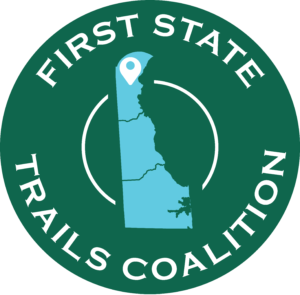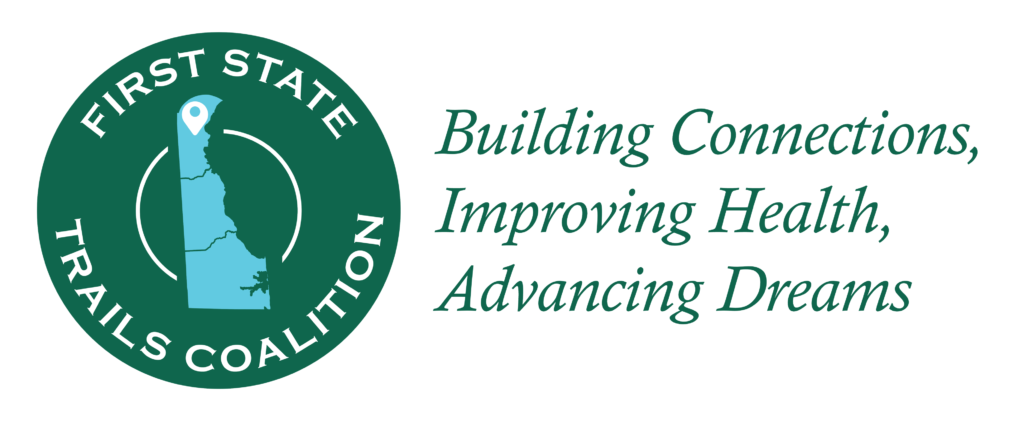Explore trail ideas using the Future Trails Interactive Map with the following capabilities: zoom in/out, choose what to display, search feature and more!
Over time we will continue to update this map with new content and capabilities as we work toward a consensus on a priority major trail network.
Do you have an idea for a new
trail or enhancement?

Delaware Greenways (DGI) formed the First State Trails Coalition in 2017 (initially named the Future Trails of Northern Delaware). Modeled after the Circuit Trails in the Philadelphia Region, DGI brought community organizations, government agencies and corporate partners together to advance a Northern Delaware trail network. With generous support from the William Penn Foundation, the First State Trails Coalition has accelerated trail development and funded trail amenities that continue to attract and engage users.
Our vision is to create a comprehensive network of trails that provide economic and social opportunities, promote healthy living, and connect Delawareans and visitors to the natural and cultural beauty that surrounds us. This vision goes beyond trail development. By leveraging the collective strengths and missions of coalition members, we are working together to ensure our trails are vibrant, well-utilized, and offer a welcoming and enjoyable experience for all.
Is your organization interested in learning more about joining the
First State Trails Coalition or partnering with us? Drop us a line!

We’ve collaborated with partners to create a trail map that not only highlights existing trails available for use but also outlines trails currently in the planning stages, along with trail ideas.
The inclusion of trail ideas presents an exciting opportunity for community engagement. Whether you’re a trail enthusiast, cyclist, or simply enjoy outdoor walks, your input can help shape the development of future trails. Together, we can plan the next set of trails for everyone to explore and enjoy.
Government funding for trail construction is limited, which can hinder the realization of our trail network’s full potential.
To overcome this challenge, we’re forging innovative public-private partnerships with our state and county government partners. By leveraging private investment alongside public funds, we can accelerate trail development and expand our trail network more rapidly than relying solely on traditional sources of funding.
We are hard at work putting together up-to-date, user-friendly maps to use in this process. These maps are designed for you to use as you use our growing trails network, as you think about where trails are needed, and as you follow and participate in getting your favorite trails built.
Check back often as we continue to update our maps and add new features.
The Brandywine Creek Greenway (BCG) is a regional planning initiative of the Brandywine Conservancy in partnership with municipalities and non-profit organizations, that are active in the Chester Valley region of Pennsylvania and Delaware.
Length: 230 mi
Surface: Mixed
Difficulty: Moderate
The Brandywine Heritage Trail project completes an east-west paved trail from the end of the Brandywine Park at Market Street in Wilmington, Delaware to Brandywine Creek State Park and the First State National Historical Park that extends into Pennsylvania.
Length: 6 mi
Surface: Mixed
Difficulty: Easy
The Claymont to Fox Point State Park/Northern Delaware Greenway Trail, a component of the Governor Printz Blvd Corridor Study, is a significant addition to the growing trail network in Delaware. The trail will also serve as a section of both the East Coast Greenway and the 9-11 National Memorial Trail.
Length: 9 mi
Surface: Mixed
Difficulty: Easy
This pathway will provide a connection from the Markell Trail at the I-295 tunnel to the Churchmans Road Pathway, providing direct pathway access for the numerous residential, commercial, office and institutional business employees, including 10,000 employees at the Corporate Commons employment center.
Length: 2.35 mi
Surface: Paved
Difficulty: Easy
The connection of the Jack A. Markell Trail to the Town of Newport will give non-motorized transportation access to highly populated areas in New Castle County including the Town of Newport to the Riverfront in Wilmington and Historic New Castle.
Length: 2.35 mi
Surface: Paved
Difficulty: Easy
For years, the trail development process has been seated in our state government. By partnering with private companies and public institutions, the FST Coalition aims to speed up the process while soliciting additional feedback from our community. We think that our community has a lot to say about which trails are a priority and where they should go. We want to make sure your voices are heard as we make decisions about what to build and when.
Whether you walk your dog on the trails each day or would like to find an off-road option for commuting to work or going shopping, you are an important part of the trail development process. We want your ideas and suggestions for developing trails and pathways that will serve your needs and will become a valuable resource to your community.
Curious to know what coalition is working on? Feel free to look through and download our recent meeting presentations.
Coalition members are also making efforts toward trail development and updates in their own specific communities.
Special thanks to The William Penn Foundation for its support of the First State Trails Coalition through grant funding. The Foundation’s mission is to help improve education for low-income children, ensure a sustainable environment, foster creative communities that enhance civic life and advance philanthropy in the Greater Philadelphia region.
Special thanks to The William Penn Foundation for its support of the Future Trails of Northern Delaware through grant funding. The Foundation’s mission is to help improve education for low-income children, ensure a sustainable environment, foster creative communities that enhance civic life and advance philanthropy in the Greater Philadelphia region.
About Delaware Greenways:
We envision a State where trails, pathways and scenic corridors connect everyone to where they want to go, empowering them to live healthier lives as they discover and enjoy the outdoors.